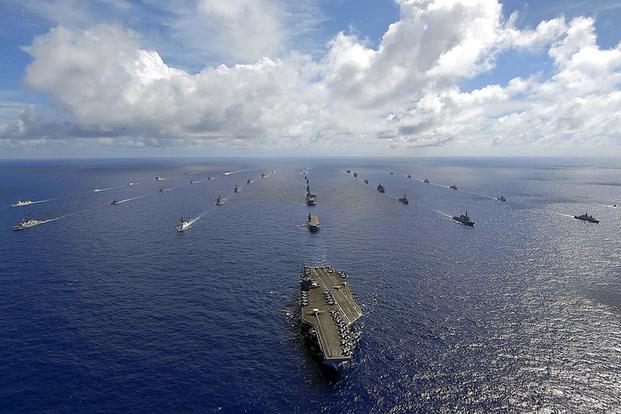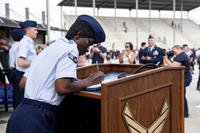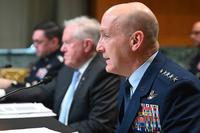If anything is meant to be shot in 3D, it's the Navy's fleet of warships, with their jutting decks, trimaran hulls, and fighters being catapulted into thin air.
Stephen Low and Bob Kresser make the absolute most of the format in their new IMAX film "Aircraft Carrier," which officially opens Memorial Day at the Smithsonian Air and Space Museum in Washington, D.C.
Cobbling together stunning aerial wide shots, unbelievably up-close footage of flight deck approaches and launches, and cutting-edge cutaway graphics, they prove that, even after decades of patrolling the seas, carriers have not lost their wow factor.
Low and Kresser say the 40-minute film is the product of a decade of work, and the wide spectrum of footage on at least four different carriers bears that out. Sharp-eyed viewers will notice that external pans of the Ronald Reagan jump to scenes on the bridge of the Theodore Roosevelt, creating a composite portrait of life on a carrier at sea.
The heart of the film is the massive biennial Rim of the Pacific exercise, where the filmmakers make the most of the columns of ships representing navies across the globe; former enemies, in some cases, now patrolling side-by-side. They contrast this effectively with sea battle scenes from history, from the bloody World War I battle of Jutland in 1916 to Midway in 1942, which saw four Japanese carriers sunk in just days.
Warfighting technology is even more brutally effective now -- the film lingers on the enhanced capabilities of the F-35 Joint Strike Fighter as an example of what is possible -- and it is essential for survival that it remains merely a deterrent, it concludes.
A final scene shows a deployment homecoming of the now-decommissioned carrier Enterprise. As families on shore wave and hold signs, a narrator intones a chilling pronouncement: "If there is another great war, nothing will rise from the ashes; neither righteous nor evil."
Below is a Military.com Q&A with Low and Kresser. Answers have been edited for length.
Q: Why make a film about carriers?
SL: I think the moment when we realized we had an interesting film was, we attended one of the RimPacs, one of the big military exercises with 55 ships and 22 nations, several years ago. And I got up in a helicopter for about 10 hours, flying around this fantastic armada, and I realized that everyone was there, the old enemies of the past. The French, the British, the Japanese, Americans. Virtually everybody was there and sailing together, working together in formation. It was very emotional for me. I'm kind of a history buff, and I saw what might have been Jutland, Trafalgar or Midway, just looking out at the ships. I wanted to in particular bring that connection with history ... that was sort of the emotional intent of the film.
Q: There's no mention of ongoing military operations against the Islamic State in the film. Why did you choose to focus on deterrence exercises instead?
SL: Well, a film is only about one thing, in my view. So to me, it was about the world sailing together, and that the aircraft carrier is the flagship. When you're in RimPac, you hear the prattle going on and the other warships are anxious to get beside the carrier for the photo op. It's a vanity thing. So you've got the old enemies, you've got the Chinese all vying for position to be next to the carrier. But, frankly, to go into a hot zone and get footage would be very difficult. Because they don't want cameras in real battle. But I like that it's kind of a benign show of deterrence. And that's a big issue, a bigger thing than whether we're shooting at somebody in particular.
Q: The first of the Ford-class carriers is now coming online, with new technologies aboard. Did you consider including the [Gerald R.] Ford in the film?
SL: We talked about that a lot. I tried to talk about that in general terms: I said the new technology is always questioning the status quo. We had other elements that we took out to shorten the film, like drones, but we thought we covered enough new stuff when you look at the littoral [combat] ships, hovercraft, Osprey, F-35B and C, that's a lot.
BK: It's very possible that at some point down the line we may be asked by the Navy actually to update the film to show the Ford class and [electromagnetic aircraft launch system]. At one point, we planned to have an end shot in the film that showcased [the Ford], but it isn't launched yet. It's possible that in the future we may update, but at this point in time, the Nimitz[-class] carriers are going to be out for a long time, the [F/A-18] Super Hornets are going to be flying with the F-35s for a long time. So it's still going to be representative of the modern age for quite some time.
Q: How were you able to get all the amazing aerial footage?
SL: The Navy allowed us very close proximity to fly right along the flightline and even sit on top of the fighters when they were taking off. It was our helicopter; we had an ex-Navy pilot. [The Navy was] nervous, but they were happy in the end. Those are unique shots, and they probably will never allow those again. The takeoffs and landings alongside the ship, Top Gun II will try to do that. They'll see this film, and they'll try to copy that, and it will be interesting to see.
Q: What message do you hope viewers come away with?
SL: I think this moment in history is completely different than the 4,000 years before. We're in a new era, a very serious moment in military history. And as I said in the end, with these weapons, as they get more and more sophisticated, they get much more powerful than people realize they are. So we really cannot fight the Third World War; it cannot happen. We flirt with war all over the world, and it's very dangerous. Because if it takes off, there's nothing left, not a blade of grass. People have to know that. Voters have to know that. They have to know they can't elect clowns, for one thing. A clown is never funny in the moonlight. And we are in the moonlight right now.
BK: We had some concerns that the ending would not be something that the Navy would embrace, but the reverse is true. I canvassed all the admirals last night [at the premiere]. And one of them said it's great because it's true, and we live this every day of our lives. I'm proud that we are telling the truth.
-- Hope Hodge Seck can be reached at hope.seck@military.com. Follow her on Twitter at@HopeSeck.





























